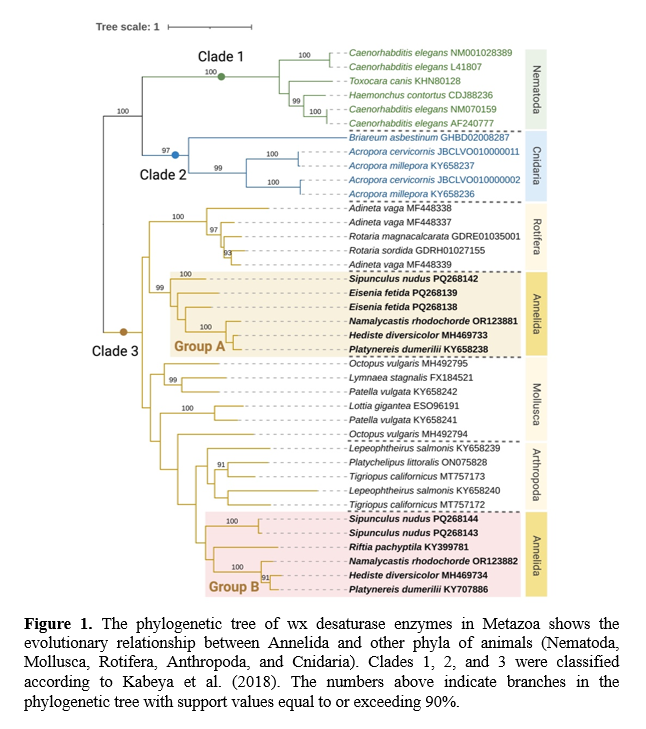FUNCTIONAL DIVERSITY OF METHYL-END DESATURASE IN ANNELIDA REVEALS THEIR POTENTIAL FOR SUSTAINABLE LC-PUFA PRODUCTION IN AQUACULTURE
Introduction
Long-chain (≥C20) polyunsaturated fatty acids (LC-PUFA) are essential nutrients with critical roles in neural function, immune regulation, and cellular membrane structure (Tocher et al., 2019). With increasing demand for sustainable LC-PUFA sources in aquaculture, especially for formulating nutritionally enriched feeds, exploring new biological systems capable of de novo LC-PUFA synthesis has become a critical research priority (Tocher et al., 2019). While vertebrates predominantly rely on dietary intake for LC-PUFA, certain invertebrates, including aquaculture-relevant annelids such as Hediste diversicolor and Platynereis dumerilii, possess endogenous biosynthetic pathways involving methyl-end desaturases (ωx), front-end desaturases (Fed), and elongases (Elovl) (Monroig et al., 2022). Among these, the diversity and functionality of ωx desaturases in Annelida remain underexplored (Kabeya et al., 2018). This study investigated the diversity and function of ωx desaturases in annelids across three major classes in Annelida: Polychaeta, Clitellata, and Sipuncula.
Materials and Methods
The sequences of ωx desaturase genes were retrieved from available annelids’ genomic and transcriptomic databases. Conserved motifs were identified, and phylogenetic relationships were established. The functions of representative genes were heterologously expressed in yeast. The ωx desaturation activity was evaluated through substrate feeding assays and gas chromatography-mass spectrometry (GC-MS) fatty acid profiling.
Results and Discussion
A total of 109 sequences of ωx desaturase genes were isolated from annelids. Phylogenetic analyses grouped them into two main desaturase groups (A and B) (Figure 1). Functional characterisation revealed distinct enzymatic activities of five ωx desaturase genes from two representative species, Eisenia fetida and Sipunculus nudus: E. fetida ωx1 and S. nudus ωx1 exhibited Δ12 desaturase activity, catalysing the conversion of 18:1ω9 to 18:2ω6, whereas E. fetida ωx2, S. nudus ωx2, and S. nudus ωx3 demonstrated ω3 activities (Δ15, Δ17, and Δ19 activities), transforming ω6 substrates into their corresponding ω3 fatty acids, including eicosapentaenoic acid (EPA, 20:5ω3) and docosahexaenoic acid (DHA, 22:6ω3). The number of ωx desaturase genes varied among species in Annelida. While most species typically possessed two desaturases—one Δ12 and one ω3—some species harbored 0, 1, 3, or even 4 ωx desaturase genes. The study confirms that annelids harbor diverse ωx desaturases capable of producing a broad range of LC-PUFA. The taxonomic distribution and functional plasticity of these enzymes suggest that annelids represent a valuable but underexploited resource for sustainable omega-3 fatty acid production. This work provides a foundation for future biotechnological exploitation of annelids in aquafeed formulation and contributes to circular economy models in aquaculture.
Acknowledgements
This study is part of the ThinkInAzul program, funded by the European Union NextGenerationEU (PRTR-C17. I1) and the Generalitat Valenciana (THINKINAZUL/2021/026).
References
Kabeya, N., Fonseca, M. M., Ferrier, D. E. K., Navarro, J. C., Bay, L. K., Francis, D. S., Tocher, D. R., Castro, L. F. C., Monroig, Ó. 2018. Genes for de novo biosynthesis of omega-3 polyunsaturated fatty acids are widespread in animals. Science Advances. 4, eaar6849.
Monroig, Ó., Shu-Chien, A.C., Kabeya, N., Tocher, D.R., Castro, L.F.C., 2022. Desaturases and elongases involved in long-chain polyunsaturated fatty acid biosynthesis in aquatic animals: From genes to functions. Progress in Lipid Research. 86, 101157.
Tocher, D. R., Betancor, M. B., Sprague, M., Olsen, R. E., Napier, J. A. 2019. Omega-3 long-chain polyunsaturated fatty acids, EPA and DHA: Bridging the gap between supply and demand. Nutrients. 11, 89.
